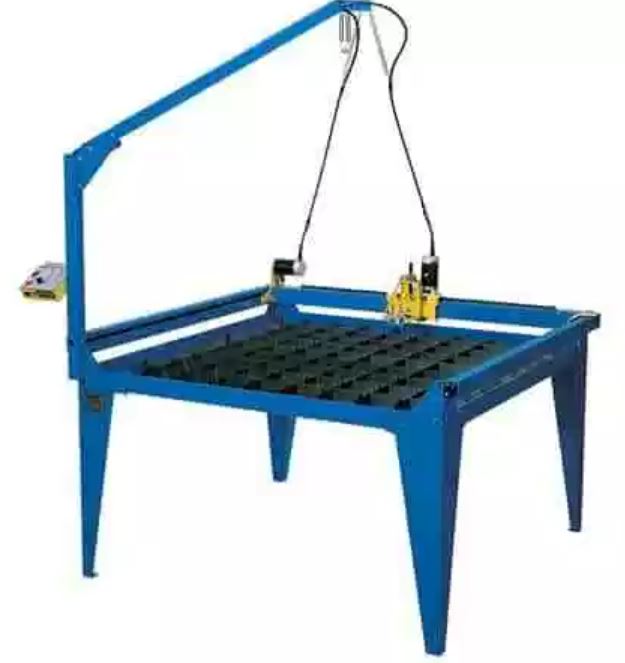A top of the line laser and plasma cutting table will easily and seamlessly help you in making a particular CAD or CAM-designed part. But the challenge will come when you need to pick one and you know nothing or not being aware of the banes and boons that each one of them comes with. Do you want to know the right option to use for your project? It would be difficult to tell without having any hands-on experience.

Plasma Cutting Tables
Plasmacam technology has been around for quite some time now, but the use of plasma technology started to become widely known around the early part of the 1970s up until the last quarter of the 1980s. However, this material cutting method got fully refined only recently.
The plasma cutting systems of those early days were somehow inefficient and flawed. They actually leave behind chips and scars on cut materials and metals. Hence, due to these imperfections, they can’t be taken advantage of for precise applications.
Today, what we have is a more refined plasma technology, and we are attributing the improvements to the different milestones that it had gone through in the past. As of this writing, there are millions of metal fabrication and manufacturing firms that are taking advantage of this state-of-the-art material cutting method to address their material cutting and process requirements.
This technology, by far, is the most preferred and the best method to use when cutting conductive metals like aluminum and stainless steel. Below are a few of the banes and boons on the use of plasma cutter.
Advantages
Low operating cost
- This type of material cutting method consumes less amount of energy when compared to laser cutting. This signifies that the plasma cutter operating cost is way lower than laser cutting technology.
Fast Rate of Production
- One of the primary reasons why plasma cutting technique is one of the most preferred material cutting methods nowadays by various industries can be attributed to its fast production rate. The use of this technology is most helpful when you are working with a project that involves the use of thick materials, which slows down laser cutters.
Cuts through thick materials
- As indicated above, plasma cutting technology allows you to handle cutting of relatively thick materials to which laser cutting technology and many other techniques fall short in.
Disadvantages
- Not highly recommended for precision cutting. Using plasma jets in cutting materials may not deliver the level of accuracy that laser cutting machines can easily provide. This should not be considered as a major problem for low-tolerance applications.
- Cut materials may necessitate some level of refinement. This material cutting method may make use of debris or dross, to help it adhere to the cut material’s side and bottom. Hence, requiring the cut material to undergo some needed refinement or polishing.
- May be used for cut conductive metals. Plasma cutting machines will cut if you make them react to a conductive material for it to deliver its work. This signifies this cutting method can only handle the cutting of conductive metals, typically aluminum and steel.
Laser Cutting Tables
Laser cutting machines are utilizing high-powered CO2 lasers in cutting various types of materials and metals. This technology has been used for several decades, and up to this day remains a good alternative among select fabricating shops and manufacturing companies that require nothing less but increased flexibility in their processes.
Below are some of the pros and cons of laser cutting tables over plasma cutting technology.
Advantages
- Cuts through a wide spectrum of materials. This material cutting method can handle cutting of metals, plastics, some fabrics and wood. Such qualities are making this cutting technique flexible for many different kinds of projects.
- High level of precision and accuracy. As opposed to plasma cutting machines, laser cutters offer users precise and highly accurate output, even though they tend to leave out heat scars or marring on the material.
Cons:
- Not being able to cut through reflective materials like copper since laser beams will just get deflected away.
- Slower rate of production. Compared to plasma, laser cutters are slower for many different applications in most metal fabrication shops.
- Difficulty in cutting thick materials. If the material subject for cutting is about a few millimeters in thickness, laser cutting machines will have a certain level of difficulty in cutting through it.
Based from above, if you will work on a project that involves the use of highly-conductive thick metals, plasma cutting method would be the most viable choice. It works to your advantage if it is going to be a high volume project. On the contrary, if precision and versatility is a top priority in your project, the use of a laser cutting table is a must. Consider making your own assessment about these two methods of cutting. By that measure, you’d be able to see which one to use, if it is a laser cutting table or a plasma cutting table.
